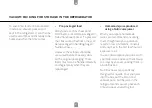
EN
65
VACUUM PACKING FOR FREEZER STORAGE (1/2)
Soft and delicate foods
To vacuum pack certain fresh foods
that have a soft and/or delicate
texture, it is a good idea to freeze
them before vacuum packing.
Otherwise, the food could be
damaged during packing (e.g. soft
bread, soft fish, etc.).
The first 24 hours of freezing will not
damage the food, either by burning
or drying. You can therefore freeze
your food the day before vacuum
packing and then put it safely back in
the freezer once packed in a NutriBag
or a NutriBox.
Liquid and sauce preparations
To vacuum pack soups, dishes in
sauce and other liquid foods for
freezer storage, there are two options:
• NUTRIBOX: Place your food in
a NutriBox box, vacuum pack it
and place it in the freezer.
• NUTRIBAG : Freeze your
preparation in a solid container.
When the preparation becomes
solid, vacuum pack it and put
the NutriBag back in the freezer
Vegetable preparations
To store vacuum-packed vegetables,
clean them, peel them, then blanch
them in steam for a few minutes
using your NutriSteam at 80 °C. This
technique will preserve their texture and
all of their nutritional benefits. Vacuum
pack them and put them in the freezer.
Defrosting bags or boxes
There are several ways to defrost
vacuum-packed foods.
• Defrosting in the refrigerator
Place the vacuum-packed foods on
the bottom shelf of your refrigerator
to ensure slow defrosting. Ideal for
meat, fish and vegetables.
• Defrosting at room temperature
Take the food out of the freezer and
leave to defrost at room temperature.
Ideal for vacuum-packed products
that are normally kept at room
temperature, such as bread or pastry.
IMPORTANT:
to defrost food vacuum packed in a NutriBag in the microwave,
cut one of the sides of the bag and eliminate the vacuum!








































